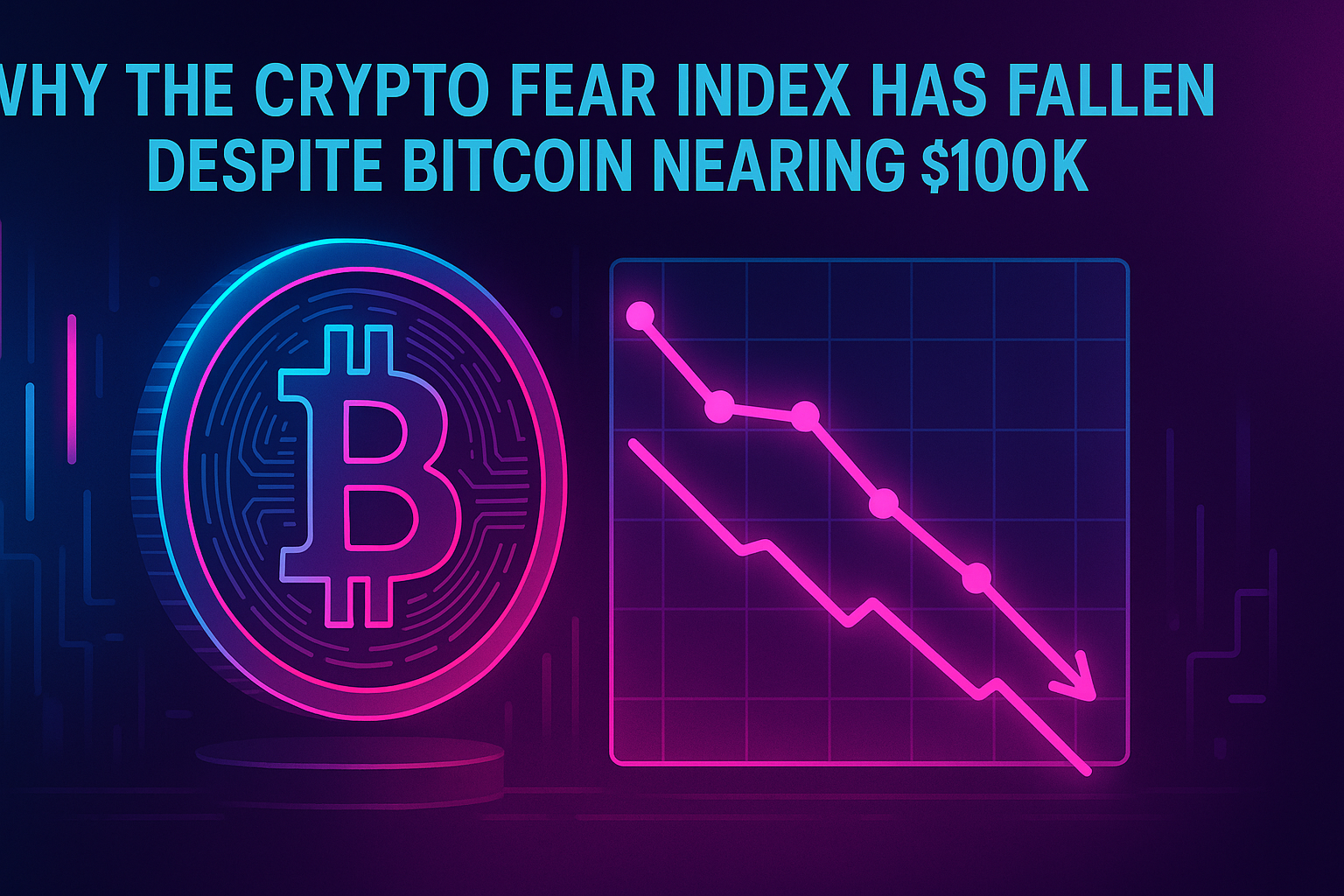Crypto Fear Index Crashes as Bitcoin Nears $100K
Crypto Fear Index plunges to extreme fear while Bitcoin trades near $100K. Discover what this means for BTC price, sentiment and your crypto strategy.

The cryptocurrency market has entered one of its most intriguing phases in recent memory. At a time when Bitcoin is hovering near the historic $100K level, the Crypto Fear Index has sharply plunged, indicating intense anxiety among traders and investors. Bitcoin Nears $100K. This dramatic divergence between price and sentiment raises compelling questions about market psychology, investor behavior, and what may lie ahead for digital assets. Bitcoin’s climb toward six figures has been celebrated as a landmark achievement, yet the emotional climate surrounding this milestone has shifted unexpectedly from excitement to fear. The result is a strange paradox: Bitcoin remains near its highest valuation ever, while market sentiment resembles a period of deep uncertainty.
This unusual combination reflects an environment shaped by rapid price swings, large-scale liquidations, macroeconomic uncertainty, and shifting investor expectations. why the Crypto Fear Index has fallen so dramatically, despite Bitcoin trading near $100K, is essential for anyone following the cryptocurrency market. The dynamics of fear and greed have always played an influential role in shaping market cycles, but the current disconnect between sentiment and price offers unique insights into the evolving psychology of crypto investors.
In this comprehensive article, we will explore why the crypto fear index has plunged, how Bitcoin’s price behavior contributes to heightened emotional volatility, and what this contradiction may signal for the future. The discussion will examine the historical significance of fear during high-price periods, the mechanics behind the index, and the ways traders interpret sentiment trends when Bitcoin approaches monumental price thresholds.
The Crypto Fear Index and Its Significance
The Crypto Fear Index, often referred to as the Fear and Greed Index, is a popular metric designed to measure market sentiment on a scale from 0 to 100. Lower scores reflect extreme fear, while higher scores indicate extreme greed. By analyzing data such as volatility, trading volume, social media activity, Bitcoin dominance, and market momentum, the index condenses complex emotional and technical signals into one easily digestible indicator. The primary purpose of the index is to provide insight into how investors collectively feel at any moment. Fear may suggest that market participants expect further declines or are hesitant to buy, while greed often implies confidence, momentum, and a willingness to take risks.
Bitcoin, as the dominant digital asset, exerts enormous gravitational pull over the entire crypto ecosystem. As a result, the Bitcoin Fear and Greed Index serves as a central gauge for sentiment across all major cryptocurrencies. When the index plunges, it reveals discomfort, uncertainty, or panic among traders, even if the price itself appears strong. This sentiment is especially important at psychologically significant levels like $100K, where expectations, hopes, and anxieties escalate dramatically.
The index matters because markets are not driven solely by technology or fundamentals. Emotional reactions often play a greater role in short-term price movements than any technical or economic factor. When fear rises sharply, it can influence everything from retail buying habits to institutional trading strategies. sentiment provides powerful context that can strengthen an investor’s decisions, particularly during periods when price appears disconnected from market emotions.
Why the Crypto Fear Index Has Fallen Despite Bitcoin Nearing $100K

At first glance, the idea that fear would surge while Bitcoin hovers around $100K seems contradictory. However, several interconnected developments help explain why sentiment has deteriorated even as the leading cryptocurrency maintains a historically high valuation. One of the most important contributors to this disconnect is the recent wave of large-scale liquidations across major exchanges.
Following Bitcoin’s earlier move above $100K, traders had grown increasingly confident and accumulated significant leverage. When the price dipped after making fresh highs, these leveraged positions unwound violently, causing cascading sell orders that forced rapid declines. Even though Bitcoin eventually stabilized near $100K, the emotional damage was done. Traders who were caught in liquidation events became more cautious, withdrawing from aggressive strategies and contributing to a more fearful market environment.
Another important factor revolves around long-term holders and institutional investors. Many early adopters and whales view the $100K level as an ideal point to take profits. Their decision to sell, even gradually, sends subtle but powerful psychological signals throughout the market. When experienced or deep-pocketed investors begin to trim their positions, newer traders often interpret this as a warning sign, regardless of whether the selling reflects strategic allocation rather than pessimism. The result is a collective dip in confidence reflected in the crypto fear index.
The macroeconomic environment adds another layer of uncertainty. Concerns over interest rates, global growth, monetary policy shifts, and regulatory developments can intensify fear among crypto participants. Bitcoin may be resilient at the $100K level, but the broader context matters. If traders anticipate potential regulatory changes or economic turbulence, they often shy away from riskier investments, even while acknowledging Bitcoin’s long-term value.
A final factor influencing the recent sentiment decline is elevated expectations. As Bitcoin approached the $100K milestone, many investors began anticipating a rapid continuation toward new targets such as $150K or $200K. When the price stalled instead of accelerating, disappointment emerged. This emotional shift—from euphoric hope to impatient fear—can be sudden and powerful. The index captures these abrupt changes in mood, revealing the collective sentiment even when the price appears stable on the surface.
Historical Patterns: Fear at High Prices and Its Implications
History shows that fear can rise independently of price, especially during transitional phases in long-term market cycles. In several previous Bitcoin rallies, periods of consolidation near major psychological levels have been accompanied by sharp declines in sentiment. For example, during earlier bull markets, fear spiked even when Bitcoin remained well above previous cycle highs. These phases often reflected uncertainty over whether the rally would continue or reverse into a deeper correction.
When fear intensifies at elevated price levels, it usually foreshadows one of two long-term outcomes. The first possibility is that the market may be entering a distribution phase. In distribution, long-term holders sell their positions to newer market participants who are less experienced or more emotional. The process can take weeks or months, and the fear index often stays low during this period because traders are worried that further downside will follow. Eventually, distribution can lead to a market correction or even a bear cycle if selling pressure intensifies.
The second possibility is that the market is experiencing a healthy shakeout within a broader uptrend. Many strong bull markets include periods where fear rises temporarily as traders recalibrate expectations. These shakeouts help eliminate leverage, flush out speculative excess, and create more stable conditions for a renewed rally. When fear appears during consolidation rather than during a sharp crash, it may indicate that the market is pausing before the next leg upward. This pattern has occurred numerous times across Bitcoin’s history, especially during multi-year bull markets.
which of these two scenarios is unfolding requires careful observation of price structure, volume trends, on-chain data, and macroeconomic signals. However, the mere presence of fear at high levels does not automatically imply a bearish reversal. In many cases, fear simply reflects hesitation as the market transitions from fast, euphoric gains to slower, more methodical consolidation.
How the Fear Index Is Calculated and Why It Has Limitations
The Crypto Fear Index relies on several categories of data to produce its score. Volatility plays a substantial role, as sharp price swings tend to elevate fear. When Bitcoin’s price experiences sudden drops or rapid fluctuations, the volatility component of the index rises, driving the overall score downward. Momentum and trading volume also contribute. When trading volumes decline or price momentum weakens, the index tends to signal fear because traders appear less willing to take risks.
Another part of the index involves social sentiment. Analysts track social media discussions, search trends, and public engagement to evaluate whether the narrative surrounding Bitcoin is becoming more positive or negative. During periods of declining enthusiasm or rising skepticism, the index adjusts downward to reflect subdued sentiment. Additionally, Bitcoin dominance relative to altcoins influences the index. When market capital flows out of speculative altcoins and back into Bitcoin or stablecoins, fear tends to rise because investors are seeking safety.
Despite its usefulness, the Crypto Fear Index is not without limitations. It is largely a reactive indicator, meaning it reflects what has already happened rather than predicting what will occur next. Sentiment metrics can remain depressed even during strong upward trends or stay elevated during prolonged declines. The index also does not account for individual investment strategies, time horizons, or risk tolerance. A long-term investor might view fear as an opportunity to accumulate, while a short-term trader might interpret it as a signal to reduce exposure. Therefore, the index should be used as part of a broader analysis rather than as a standalone decision-making tool.
Bitcoin Near $100K: A Psychological Battle Zone

The $100K region represents far more than just a numerical milestone. It is a symbolic threshold that evokes intense emotions among traders, both positive and negative. Crossing $100K for the first time marked a historic achievement, but remaining near this level has introduced a new type of psychological pressure. Investors are now debating whether Bitcoin’s presence around $100K signifies the beginning of an extended consolidation phase, the peak of the current bull cycle, or the prelude to another dramatic rally.
The plunging Crypto Fear Index amplifies this tension. When Bitcoin hovers near a milestone like $100K while sentiment collapses, the market enters a state of emotional conflict. Some traders view fear at such high levels as a sign that the rally may be exhausted. Others interpret the same fear as a signal that the market is preparing for a breakout, especially if price stability accompanies sentiment weakness.
Because Bitcoin often consolidates around major round-number levels before deciding its next direction, the current environment should not be surprising. During these phases, speculative activity cools, leverage resets, and traders reassess expectations. The low sentiment reading may simply reflect this natural process rather than forecasting an immediate downturn.
How Traders Interpret the Fear Index When Bitcoin Is at Major Levels
Traders respond differently to extreme fear depending on their strategy, time horizon, and risk appetite. Long-term investors usually interpret fear near $100K as an opportunity to accumulate without rushing. They often view Bitcoin through a multi-year perspective, considering the broader market cycle and historical growth patterns. To these investors, fear represents a chance to strengthen positions quietly while the market remains uncertain.
Shorter-term traders, particularly swing traders, often combine sentiment analysis with technical indicators when making decisions. They watch how price behaves around key support and resistance levels and then evaluate whether fear is justified. If price stabilizes near support while the fear index remains low, these traders may see it as a sign that sentiment has overreacted. This can create potential entry points if price action supports their thesis. If price weakens significantly while fear is already high, they may avoid new positions altogether until sentiment begins to recover.
Professional traders sometimes use sentiment as an element of risk management rather than as a direct signal. When fear dominates, they may reduce leverage or adjust exposure while waiting for volatility to settle. However, they rarely rely solely on sentiment. Instead, they integrate it into a comprehensive strategy that accounts for price structure, macro conditions, liquidity, and market depth.
The Role of Market Psychology and LSI Concepts in Fear
Several related concepts, often appearing as LSI (Latent Semantic Indexing) keywords, deepen our of the relationship between sentiment and price. Terms such as Bitcoin market sentiment, crypto market cycle, Bitcoin bull market, BTC price prediction, and market psychology all connect to the same underlying idea: human emotion guides market behavior. Whether the crowd is optimistic, fearful, greedy, or confused, those collective emotions eventually influence market movement.
Market psychology becomes particularly pronounced near key levels like $100K because expectations tend to swing wildly. Optimistic investors envision continued growth into the six-figure zone, while anxious traders fear buying near a potential top. This emotional tug-of-war is captured by the Crypto Fear Index, which compresses these conflicting sentiments into a single reading.
When Bitcoin remains stable near $100K while the index plunges, it suggests a market struggling with uncertainty. Traders know the price is high relative to historical levels, but the absence of immediate continuation leaves them unsure whether to expect consolidation or reversal. This indecision creates the type of emotional environment where fear can escalate rapidly, even if price does not.
See More: Bitcoin Nears $100K Can BTC Break This Wall
What the Plunging Fear Index Means for Bitcoin’s Next Move
The decline in the Crypto Fear Index during a period of high Bitcoin prices indicates that the market is reassessing its position. The combination of profit-taking, liquidations, macro uncertainty, and shifting expectations has produced an atmosphere of caution. However, fear alone does not dictate Bitcoin’s next move. Instead, the index serves as a reflection of collective uncertainty.
If Bitcoin can maintain support near $100K while sentiment remains depressed, this could lay the foundation for a future rally. Fear during consolidation often precedes strong upward movements, especially when selling pressure decreases and long-term demand strengthens. Conversely, if Bitcoin falls decisively below key support levels while fear is already high, the market may experience a more pronounced correction.
Ultimately, the index signals that traders are not convinced of immediate continuation. They are evaluating whether the recent highs reflect sustainable value or temporary exuberance. This tension between caution and optimism is shaping the current market landscape.
Final Thoughts
The sudden plunge in the Crypto Fear Index at a time when Bitcoin hovers near $100K highlights the complex nature of market psychology. Price does not exist in isolation; sentiment, expectations, and emotional responses all play essential roles in shaping the direction of the market. While fear may seem alarming on the surface, it often presents opportunities for those who remain level-headed and strategic.
As Bitcoin continues to navigate the critical $100K region, the emotional landscape becomes just as important as analyzing charts or evaluating fundamentals. Investors who maintain perspective, manage risk responsibly, and avoid emotional decision-making are better positioned to benefit from whatever comes next. Whether the market is preparing for consolidation, continuation, or correction, the key to navigating this moment lies in patience, clarity, and disciplined analysis.




